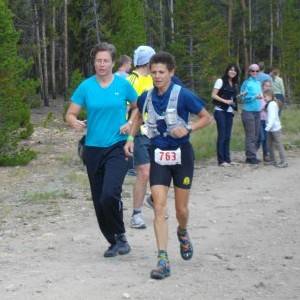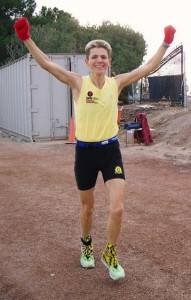 Now that some of you have completed, or will be completing, your fall marathon, it’s time for that ultimate challenge: the ultra marathon.
Now that some of you have completed, or will be completing, your fall marathon, it’s time for that ultimate challenge: the ultra marathon.
I will be the first to tell you that I have no desire to run ultra marathons, races longer than 26.2 miles. Marathons are long, painful, mentally exhausting affairs that take hours of training and incredible stamina to finish. I’ve done two, and knowing how hard they were, two is enough for me. To go beyond a marathon, to go ultra, takes more than this bag of bones can handle. But for some, an ultra is the ultimate high, where 26.2 miles just doesn’t cut it, and you aren’t a real runner until you’ve done your first ultra. What does it take to push the body beyond 26.2 miles? First, let’s learn a little about the ultra itself.
Ultras usually fall into one of two categories: distance and timed. Distance races vary from as few as 30 miles in a day to over 3,000 miles over several weeks. The Self-Transcendence 3100 Mile Race in Jamaica, Queens, New York claims to be the longest ultra in the world. The 2010 winner, Asprihanal Pekka Aalto of Finland, won it in 46 days, 7 hours, 37 minutes and 24 seconds (or roughly 65 miles a day). The Self-Transcendence is, admittedly, an outlier. Most ultras are around 50 to 150 miles.
The Badwater Ultramarathon is probably one of the most extreme and most well known. Run over 135 miles in July in Death Valley, California, Badwater is hot. Temperatures on race day easily climb into the 130 degree range. It is selective. Not everyone who applies for entry gets it. There are tremendously tough prerequisites to run the race, too. This year’s first male finisher completed it in 24:44:48, and the first woman finished in 26:16:12.
The C-U area has its own ultra in the 30 mile Clinton Ultra, put on by Second Wind Running Club. It takes place at Clinton Lake, about 30 miles west of Champaign.
Timed ultras differ from distance ones in that the goal is to run against the clock, rather than a specific distance. Howl at the Moon, put on by the Kennekuk Road Runners, is best known local timed ultra. Participants run for up to eight hours, and the race claims to be the largest timed ultra in the United States, with 284 participants this year. The overall winner was Brandon Janosky of St. Louis, Missouri, with a distance of 53.14 miles. The overall female winner, Christine Crawford of Whitewater, Wisconsin, came in at 49.85 miles.
Ultras mostly occur on trails, not on roads. At these distances, there is no logistical capacity to shut down hundreds of miles of roads for runners. Plus, trail running is, in many respects, better for the body due to its softer footing.
The thing that I’ve noticed about ultra runners is that the distances they run are, to them, pedestrian. Running a marathon after work on a Thursday evening in training is like you or me strapping our shoes on for a six-miler. Mundane. Ultra runners also travel great distances for a run. Local C-U ultra runners are known to, on a spur of the moment, drive to Pennsylvania or some other far off locale for an ultra run some weekend. How do they do it? Why do they do it? What do they get out of it? What are some of the physical concerns an ultra runner may experience?
 Tracy Thomas is a celebrated local ultra marathoner with many under her belt and a lot of hardware to prove her skill. She has won the McNaughton Park 100 mile trail run in Pekin, Illinois in 2006, the Kettle Moraine 100 Endurance Runs in 2005 and 2006, and was the masters champion at the Vermont 100 Mile Endurance Run. Her greatest accomplishment, she says, was her overall win at the Arkansas Traveller 100, beating the nearest first male finisher by over 42 minutes.
Tracy Thomas is a celebrated local ultra marathoner with many under her belt and a lot of hardware to prove her skill. She has won the McNaughton Park 100 mile trail run in Pekin, Illinois in 2006, the Kettle Moraine 100 Endurance Runs in 2005 and 2006, and was the masters champion at the Vermont 100 Mile Endurance Run. Her greatest accomplishment, she says, was her overall win at the Arkansas Traveller 100, beating the nearest first male finisher by over 42 minutes.
~~*~~
Why did you start running ultras?
I started running ultras when I ‘hit a plateau’ in the 3:20s in marathons. I figured that this plateau was just due to age (I was in my late 30s), and so I figured if I was going to be slowing down, I’d give myself an excuse to slow down. So, I picked a mountain 50-miler. Five days after that, I signed up for my first 100-miler.
Is there a different philosophy to ultra running rather than just marathon running? It seems to me that it takes a certain type of person to do ultras. Can you describe, in your opinion, what makes a good ultra runner?
The ultra is just a longer marathon. If you are a fast marathoner, who can really push yourself, you are going to need to slow down a bit, unless you are only running a 50K (31 miles). If you run the race properly, you won’t ‘hit the wall,’ (unless you don’t fuel properly), but you will still have the ‘roller coaster’ ride. You will almost always have ups and downs in the race, and that is why many people insist that ultras, especially the longer ones, are more of a test of the mind, than anything else. If you just don’t give up, and are able to talk yourself out of quitting just because you are fatigued and feel crappy, then you will make it through.
One of the big differences between marathons and ultras is that most ultras are on trails and you have many more hills/climbs/mountains. All but the very top elite ultrarunners walk the hills and run the flats and downs.
What makes a good ultrarunner: Someone who is motivated to train enough. Someone who is prepared to be miserable and tired and still keep putting one foot in front of the other. Someone who is patient enough to just ‘GO OUT SLOW’ and take walk breaks early and often-before you need them. My motto in long ultras is this: ‘Never run something (hill) now that you will be walking later.’ In other words, don’t run a hill now if you know you won’t be able to run it in 40 miles. Just walk it now and save your energy.
Tracy is a personal trainer and running coach. She also owns Body Mechanic Fitness. As a trainer, she has a lot of experience with clients and their physical ailments. What are the typical running injuries that ultra runners face beyond what marathon runners face?
Many of the injuries are the same, but typically you get the main ‘overuse’ or ‘repetitive stress’ injuries. Shin splints, Illiotibial Band Syndrome, plantar fasciitis, Achilles tendonitis, tight piriformis and tight hamstrings. . . . Many of these stem from exercising in only the saggital plane and not strengthening the lateral and medial muscles of the body. Thus, joints aren’t strong in every plane and weakness in muscles can lead to tightness as well as laxity in joints. To avoid injuries, athletes need to not only cross-train, but to make sure they address muscular imbalances and strengthen the entire body.
Ultra marathons are no more dangerous than any other running races if you’ve trained for them, though you most likely don’t hear about ultra runners unless something bad has happened. This was the case last year when ultra runner Gina Natera-Armenta became lost on a long run with her brother-in-law. Read a full account of her ordeal here. You still need to take the normal precautions you would for any running event, mainly, know the course, consider running with a friend, stay hydrated, eat regularly, and bring your cell phone. Also, it wouldn’t hurt to know your body. Know what you are able to do.
The Self-Transcendence, that race in New York, really does epitomize what ultra marathons are all about — facing that inner struggle to give up and transcending yourself beyond your limits.









 One of the big differences between marathons and ultras is that most ultras are on trails and you have many more hills/climbs/mountains. All but the very top elite ultrarunners walk the hills and run the flats and downs.
One of the big differences between marathons and ultras is that most ultras are on trails and you have many more hills/climbs/mountains. All but the very top elite ultrarunners walk the hills and run the flats and downs.